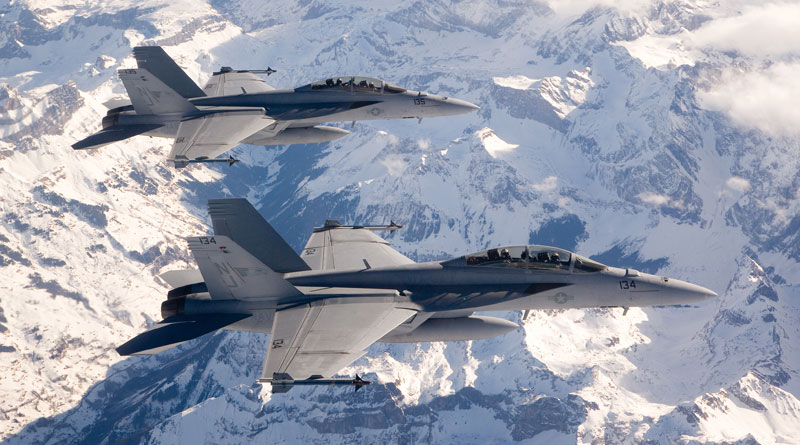The procurement of carrier-based fighters for the Indian Navy should be fast-tracked
Mihir Paul
The Indian Navy witnessed a slew of crucial developments regarding acquisitions that were fast-tracked by the ministry of defence (MoD) last year. While the procurement of MH-60R multi-role helicopters and the Naval Utility Helicopter (NUH) programme saw progress, the acquisition programme for the navy’s multi-role carrier-based fighters didn’t see much action besides the navy showing its continued support towards the LCA Naval programme with hopes that the future versions (Tejas Mk-2) would be operationally compatible with the upcoming ‘Make in India’ carriers.

To fulfil the requirement for multi-role carrier-based fighters (MRCBF) to serve aboard the upcoming ‘Make in India’ carriers, INS Vikrant and INS Vishal, in early January 2017, a Request for Information (RFI) was floated by the MoD for 57 MRCBF. This is the largest procurement of naval fighters in recent times through an open tender. At present, the Indian Navy has 45 such multi-role carrier-based MiG-29KUBs for operations for INS Vikramaditya and the under-construction INS Vikrant. The proposed procurement for the 57 MRCBFs came after almost 10 years when the Indian Navy had last acquired MiG-29Ks from Russia. The RFI followed from the news that LCA Tejas was no longer being considered for Indigenous Aircraft Carrier I (IAC I) since its first naval prototype (Tejas MkI) was too heavy, thus making this acquisition even more significant.
However, the procurement for new carrier-based fighters, like all major acquisitions till date, also has the potential to fall prey to technical and financial issues along with delays like in the MMRCA acquisition programme. What makes this acquisition even more challenging is that the MRCBF’s must be able to accommodate both Catapult Take Off Arrested Recovery (CATOBAR) and Short Take Off Arrested Recovery (STOBAR) launch methods. INS Vikramaditya and INS Vikrant have STOBAR (ski-slope launch) while the third carrier, INS Vishal, is likely to have CATOBAR. Since most naval carrier-based fighters in service around the world aren’t initially designed for both launch platforms, the quest to find a fighter that meets these requirements while also being able to carry an operationally effective payload may prove to be arduous.
The four carrier-based fighters being considered for this procurement are Boeing’s F-18 Super Hornet, Saab’s Sea Gripen, MiG-29K, and Dassault’s Rafale (naval version). These Original Equipment Manufacturers (OEMs) are currently being considered for the upcoming Request for Proposal (RFP) that was supposed to be issued in 2018. While the RFI didn’t specify whether the navy wanted a single-engine or twin-engine MRCBF, given the expanded roles and capabilities required, it will most likely be a medium-to-heavy, twin-engine one. In an interview with FORCE last year, Chief of Naval Staff, Admiral Sunil Lanba confirmed that the RFP for the fighters will now be issued in 2019 and that the fighters would be inducted around the time IAC-1 (Vikrant) is operationalised by the Indian Navy.
The Contenders
Boeing F/A-18 Super Hornet
The F/A-18 Super Hornet is not only the most produced naval fighters in operation but also one of the most combat proven platforms when pitted against other carrier-based fighters. Given that the US Navy and US Marine Corps are still using F/A-18s, the Indian Navy will be insured against obsolescence. Boeing is fielding the F/A-18IN variant which is based on the F/A-18 E/F and can be carrier launched. The Super Hornet has a major ‘Make in India’ bid going that looks to fulfil the IAF’s MMRCA requirement (in MMRCA 2.0). This could favour this platform given that the MoD wants these carrier-based fighters to be built in India. The variant being offered to India will be the Advanced Super Hornet with a new AESA radar. Raytheon’s APG-79 AESA radar is being offered on the aircraft with a limited Transfer of Technology (ToT) on the radar, up to the level approved by the US government. The F/A-18 is primarily designed for CATOBAR carriers but Boeing has already carried out simulations to verify the fighter’s ability to conduct STOBAR ski-jump launches. Boeing has also stated that the Super Hornet could be STOBAR launched while carrying an operationally effective payload. Boeing and Tata Industries have a joint-venture company at Hyderabad for Apache fuselage and other aero-structures. The new entity would supply components for Boeing military aircraft world-wide, including for the Super Hornet. This is the first time the Super Hornet is being offered for production in a foreign country.
You must be logged in to view this content.

